Reliability bites: 2014 japanese cars take a hit.
reality bites: 2014 japanese cars take a hit. consumer reports survey questioned 1.1 million owners. via washington post [RK]
reality bites: 2014 japanese cars take a hit. consumer reports survey questioned 1.1 million owners. via washington post [RK]

[DesignApplause] Jean-Marie, tell us a little bit about the project you’re working on for Coalesse.
[Jean-Marie Massaud] We are working with Coalesse on a liberal amount of products. which are not just products. Today, companies realize that work is being rephrased, today it’s about work and life. You see, the space and timeframe for working has changed, and Coalesse is trying to provide solutions that’s linked with this new way of living and working.
Some of us either have to work or if lucky, choose to work. My life today is to work on vacation and it took 15-years to accomplish this. I have been working this way for two years. I live near Saint Paul De Vence, in the city of La Colle-Sur-Loup. Part of my team is in Paris, part of my team is in Brittany.
[DA] How big is your team?
[JM] We have 15 people, not so much, but involved in big projects in architecture and the car industry. And these are few projects, not so many. I live alone with my family and I don’t have any people that are working with me in La Colle-Sur-Loup. And I work with my graphic tablet, receiving and sending drawings. I’m linked everyday, but I live on vacation.
I’ve proposed that my team also work on vacation. A lot of them want to stay in Paris, in Brittany. And they are not students, which was another kind of life scenario. They are efficient professionals, not obliged to be a prisoner of an office tower at work.
And so we tried to develop with Coalesse this idea, because it’s natural for them. It’s can be said, it’s a philosophy in which they believe. And when they came to visit me, I told them my dream is to be able to work and also be able to enjoy simple dalliances. So after I drop off my kids to school, I have a coffee. I’m looking at the sea, looking at the mountains. There is the snow.
During the coffee, I discuss with the waiter – he knows me – “Voila! What are you doing?” “I don’t know.” And: chat, chat, chat, chat. After half an hour, it’s done. And then I have to communicate. So I come back to the Wacom tablet, usually, to sketch. Or, when I have a very good connection with the iPad a video conference is possible.
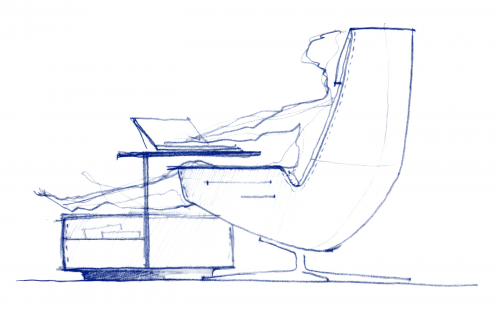
And once I send the sketch to my office I’m free! And because I’m free I might do some sailing. And in this space my brain, packed full of many things suffers little constraint but just thinking about what’s next. I am always writing notes. While lying on the bed when I’m at the hotel or after I go do a run like I did this morning, I write more notes. And the work of the day is done.
[DA] So you write many many notes. You draw with a tablet, you have an Ipad, do you write digital notes or on paper?
[JM] I have – what do you say – a love for notes? My office manager tells that I have too many papers. My system works for me though I’m still waiting for an iPad with a graphic sensitivity.
[DA] There are applications and pressure sensitive styluses for the iPAd.
[JM] Not quite, yet. What I would love, let’s say, during a video conference, sketches could be sent, corrections made on the tablet and then sent back. It would eliminate the need to refine the sketch on paper and scan it. I could correct the exact curve, or exact section… I had this same conversation with Jonathan Ives three years ago. There’s a market. My freedom is linked to this product!
[DA] You want to do everything while on that boat!
[JM] That would be fantastic!
[DA] Tell us what your doing with Coalesse.
[JM] Our first attempt was to put the task into perspective. Coalesse creates classic furniture that’s relevant for the work space or home. I told them the best lounge chair in thw world is the Eames chair from Herman Miller. There’s no other product so smart and competent. If we are to do something – another one great one – maybe it’s not about the architecture, maybe it’s about the integration of your way of living, the sensitivity of the finishes. And so the final customer or the architect specifying the project, makes this product their own because of the link to life, to work. All of this made possible, not with a high-tech solution but with a lounge chair with an ottoman.
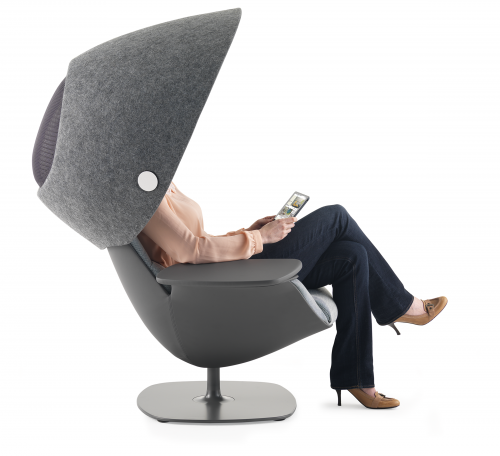

The chair is kind of an evolution. It now has a movable work surface in which to place an iPad, to…
[DA] Take notes. Jean-Marie, this chair is designed for you!
[JM] Yes yes, quite possibly. There’s a light in the canopy. A hands-free clip-on device holder. We can video conference in this lounge. A further evolution is maybe the need of intimacy, because if I am in a hotel, a creative agency, there is need for quiet space with little visual disturbances so we pull over the canopy.
If we reconsider the space of walking in an office or a dorm, the space has to be thoughtless. It only has to look like your private place, because more and more people want to feel- how do you say- to feel love more than efficiency. (laughing) So we developed these kinds of ideas.
And the ottoman is more than that (removing the cushion), it is storage space.
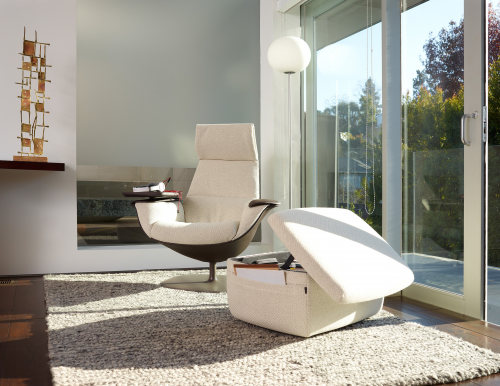
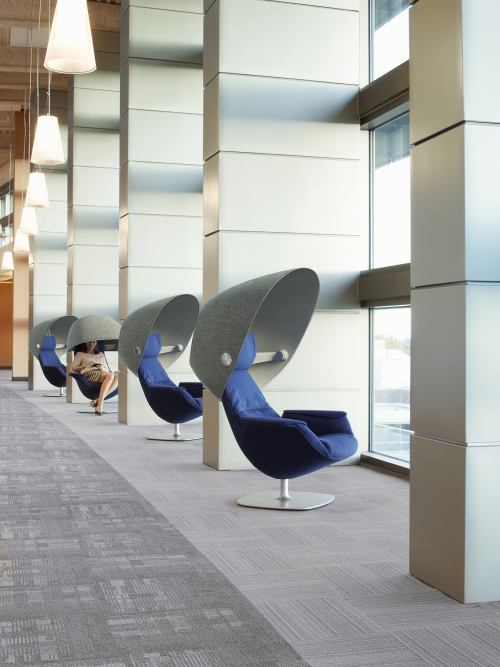
And the hood is very light. And there’s no need for electrical wire because of bluetooth, a wi-fi area. The beauty of the hood is how minimal and simple, a really elegant small space.
[DA] The acoustics under the hood is really good. Very little outside noise and we are in a very noisy showroom. You know it looks very twenty-second century.
[JM] Yes, but at the same time, the space is neither the mechanical expression where you feel it’s an office, and yet it’s the office of the familiar, something very natural.
[DA] Jean-Marie, what did you learn from this project?
[JM] Many things, but of interest to me, firstly, I learned to work with American companies. Yes. Working with Coalesse and the collection involving many pieces and several design destinations. No offense here but my experience working with European and an American company, the cultural differences became apparent first hand.
First of all, for me with this experience there were many more people involved on this project. In general, European meetings tend to be smaller, maybe two or three. But this collection, at times maybe 15 people in a meeting and I learned to be more clear in the detail of the message I have to give, because we are doing a lot of meetings. And everybody is very good at method, a very strong method in order to be sure that everybody (15 brains with their own culture and knowledge) shares the same content.
And it was interesting how to fertilize ideas together, with different cultures with the same vision, the same stakes. The vision was simplicity, to create some evolution, and not for the day after tomorrow. To be elegant, but in a sensitive way, not just to be efficient or just to be smart. Just to be elegant. And a merger of all things in today’s world, the work, the play, a way of living. Very cool and I love this feeling of being cool. Really.
[DA] Tell us a little about your philosophy, how materials seem to drive your solutions. The Toyota Me.We is a good example. Do the materials come into play with a project like this?
[JM] Material is just one part of the puzzle we need to accomplish a vision or project. Design adds value in this respect because design is about creative synthesis, and there are a lot of stakes we wish to unite. There is of course, the quality of the service we want to provide. There is usually an economical scenario we need to factor in. So we have to do things which are smart, we can share and to create value.
There is, the technical means and the technical states about lightness, about doing better with less, about the world’s soul which speaks to sustainability. So materials are super important.
For example, the hood on the lounge is made of synthetic felt. It’s made of reclaimed materials, and we see it mostly in a car, the ceiling, the doors. Actually the construction of the canopy, is very much like the ceiling of a car. The synthetic felt is easy to work with and do not forget, our brain is programmed to associate felt with acoustics, noise dampening. The cover on the lounge not only has good acoustics but it persuades your brain too. When you see it, you’ll understand. It will be quiet inside.
[DA] Tell us about the Massaud Collection.
[JM] I think the chairs are quite unique. And there are so many office chairs! For me it wasn’t a question of good taste or bad taste, I wanted to provide some sort of affordable solution of – a chair being a chair. The solution has to be elegant, but it’s about doing business. It’s using the same shell, the same little wire frame for all options.
And we do a lot of things with this principle. The collection doesn’t look plug-n-play, but it is. It’s a flexible collection which gives you, the person, many options to choose your condition, choose your identity. And these options both mix and match, there are low solutions and high solutions. The same with the armrest. And far from the very technical office chair.
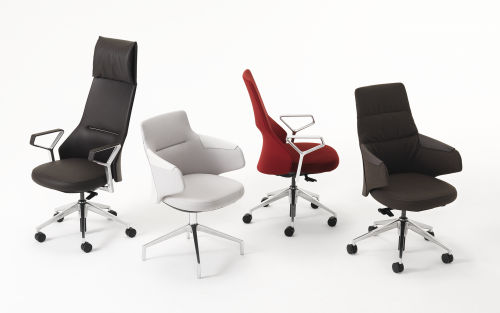
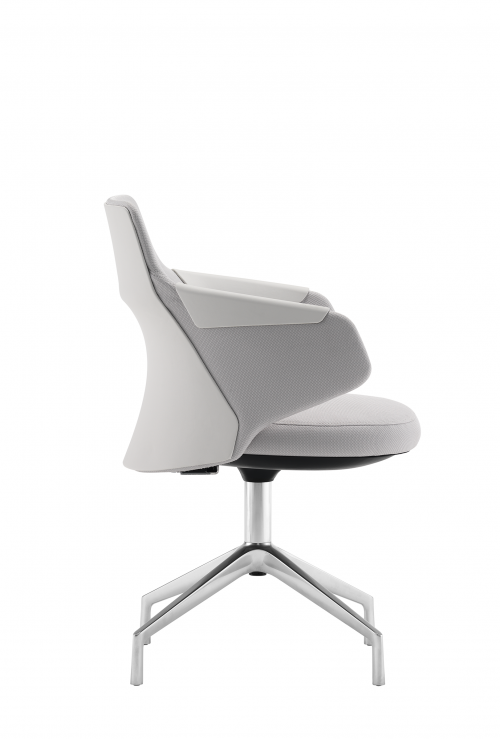
The low chair is very low and the armrest disappears to make it more – could be like the shoulder bag for a girl. This chair for the female, it’s my favorite.
[DA] Yes, I like the armrest. Very stylish. Very efficient.
[JM] Efficient but not too arrogant.
[DA] Can you tell us a little about the Toyota Me.We concept car?
[JM] For me, this is an urban car concept which implies what you might expect. First, your eyes tell you it’s not about arrogance or sharpness of the shape- it’s friendly. It’s for the guy walking the street and seeing the car, it catches his eye. It’s for the user who isn’t scared anymore about the scratch or the maintenance of the scalp. Your eyes tell you don’t worry.
[DA] So the anti-crisis car.
[JM] Yes! There are dozens of materials or processes that are smart and we have to choose. The car appeals to many because we have many options to choose from. It has an aluminum frame and renewable bamboo floor and also recylable polypropylene panels with not only color options but texture options. After enough scratches and maybe dents simple replace a panel. The material here was a big part of this vision. You have to crystallize this vision in matter. Material is very important.
1/2> lounge with hood
3/4/5> lounge
6> height adjustable, swivel tablet | cord pass through at base for charging devices
7> ottoman storage
8> low-back executive
9/10> mid-back executive
11/12> high-back executive
Jean-Marie Massaud is a French architect, inventor and designer. He was born in Toulouse, France in 1966. Massuad graduated from the École Nationale Supérieur de Création Industrielle – Les Ateliers, Paris in 1990 and began working with Marc Berthier. In 2000, he co-founded the Studio Massaud with Daniel Pouzet and expanded his interests in the fields of architecture. [ massaud ] [ coalesse ]
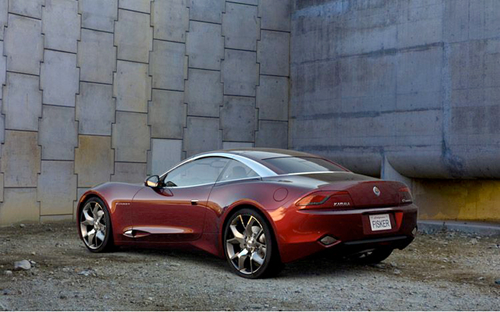
While we wait for “plug-in” Volt and Prius to arrive in 2010 there are two exotic automakers ready to go. Tesla ( $128,000 USD two-seater ) and Karma ( $87,900 USD ) Let’s look at Karma.

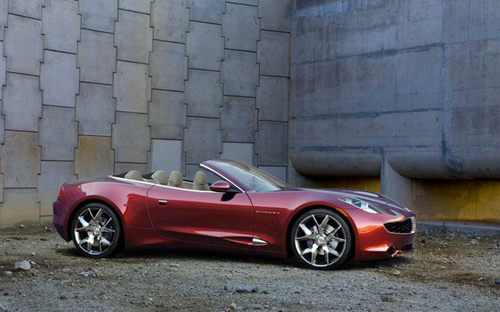
above: The Karma S — for Sunset — concept that debuted at the Detroit auto show shares its gas-electric drivetrain with the Karma sedan but wraps it in an even sleeker two-door body that could see production within two years.
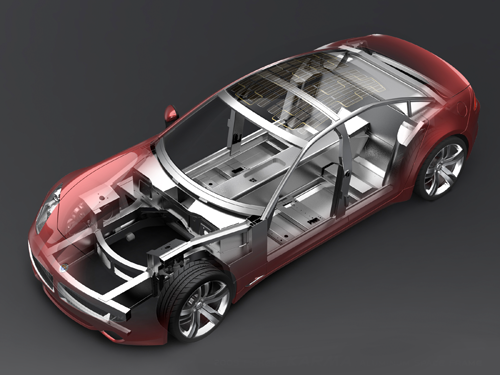
above: A rooftop solar panel on the sedan comprised of 80 cells divided into four zones. Output is 130 watts, and it helps charge the battery and, when the car is parked, keep the interior cool.
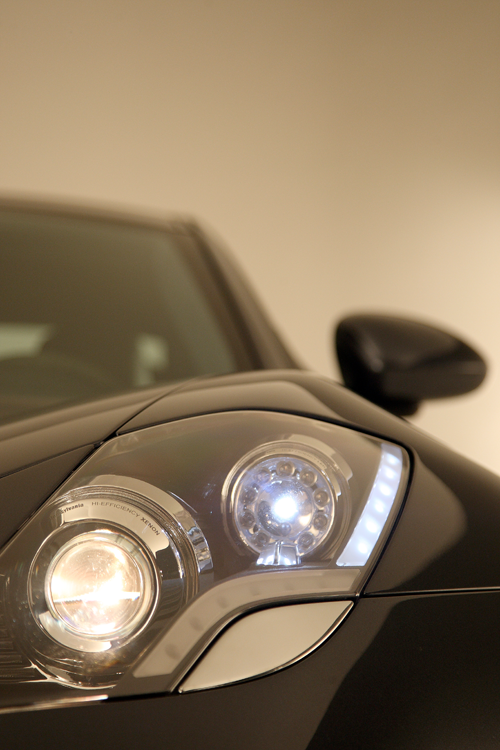
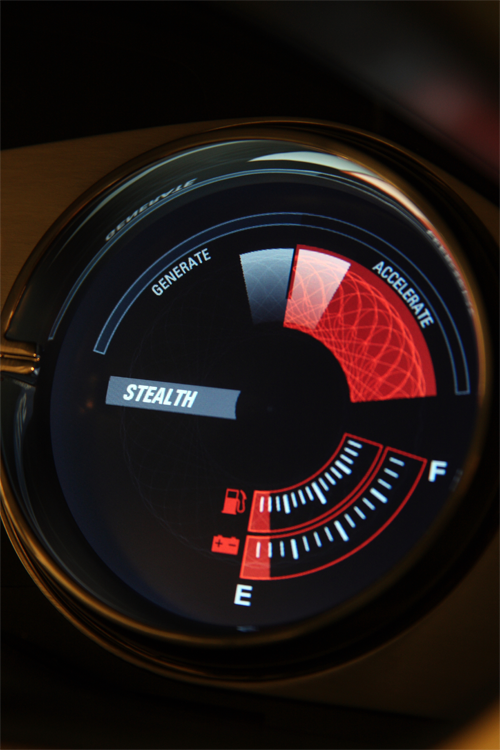
“The Karma’s material philosophy balances sensuality and accountability,” Fisker says. “We have gone to great lengths to use only environmentally conscious, classic automotive materials that support a commitment to our eco initiatives.”
Under the skin, the 4-door and 2-door cars use the same gas-electric drivetrain, which Fisker calls Q-Drive, developed with help from Quantum Technologies. The Karma will work much like the Chevrolet Volt, delivering 50 miles of all-electric range before the 2.0-liter turbocharged four-cylinder engine kicks in to drive a generator that will recharge the 22.6-kilowatt-hour lithium-ion battery and provide juice to keep the car moving. A rooftop solar panel on the sedan comprised of 80 cells divided into four zones. Output is 130 watts, and it helps charge the battery and, when the car is parked, keep the interior cool. Toyota’s got something similar on the 2010 Prius it unveiled a few hours before the Karma S broke cover.
Beneath the car’s aluminum-and-composite body lies an aluminum spaceframe chassis that cradles two electric motors that together produce 300 kW (408 horsepower) and a stunning 959 foot-pounds of torque. Fisker claims the sedan, which weighs 4,650 pounds, will do zero to 60 in 5.8 seconds. Top speed is limited to 125 mph.
Although the Karma’s electric drivetrain is a proprietary system designed in conjunction with Quantum Technologies, the engine, air-conditioning system, steering column and other “bits and baubles” were pulled from the GM parts bin, says Fisker spokesman Russell Datz.
Fisker may be getting help from GM, but, like Tesla Motors, he’s bringing a new business model to the auto industry.
His company isn’t financed by stockholders or government loans, but by venture capitalists, including the powerhouse firm of Kleiner, Perkins Caufield & Byers. It is outsourcing much of the work to top-tier suppliers like Edag Engineering and Magna Intier, and the cars will be assembled by Valmet, the Finnish firm that builds cars for Porsche. Fisker Automotive bought a big share of Advanced Lithium Power, so it’s got a battery supplier lined up.
Still, Fisker still has to get its car certified by the feds — an arduous task that some industry insiders doubt it will complete before the end of the year, particularly since we haven’t seen running cars. It also has to establish a dealer network, but Fisker says 40 dealers will be up-and-running by year’s end. Some seasoned industry watchers say Fisker undoubtedly will get his cars built, but they aren’t betting he’ll do it by the end of the year.
The convertible added just 15 percent to the cost of building the sedan, which carries a retail price starting at $87,900. Another $18,599 gets you the “Eco-Chic” model, which has an interior free of all animal products, with woodwork made from submerged logs (no clearcutting required).
Fisker says he’s received orders for 1,300 vehicles, and he tells The New York Times his company would turn a profit if it sold 4,000 cars annually. The goal, he says, is to sell 15,000 worldwide each year.
Specification:
All electric with range extender (Q-Drive)
Dual mode option: power mode and stealth mode
0-60: under 6 seconds
Top speed: 125 mph
4-door
22 inch wheels
Producer: Karma by Fiskar
Italdesign Ggiugiao Quaranta concept powered by Toyota Hybrid Synergy drive
Uncompromising innovation in Giugiaro tradition
An ‘extreme’, clean-technology project embodying 40 years of styling research and engineering celebrated by Italdesign Giugiaro in Geneva
The ‘Quaranta’ project is a concept car designed to celebrate Italdesign Giugiaro’s forty years of business in styling and technological research at the service of the automotive sector. The Quaranta, world-premiered at the 2008 Geneva International Motor Show, is a synthesis of Italdesign Giugiaro’s unmatched experience of automotive design: from city cars to super sports-cars, from MPVs to medium-engined saloons up to and including luxury flagships and environment-friendly SUV, not to mention light/heavy duty commercial vehicles, in complete cooperation with leading manufacturers all over the world. (more…)
All content ©2007 > 2024 DesignApplause
Notifications